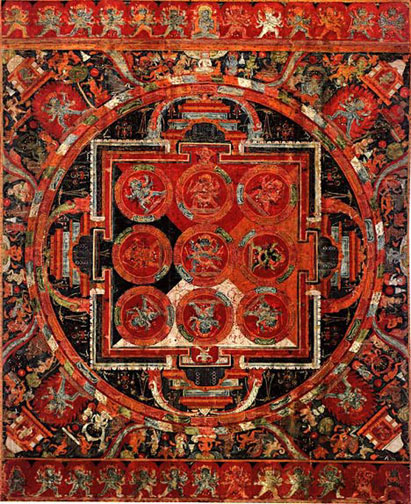|
Mandala of Vajrahumkara
rdo-rje hum-mdzad-kyi dkyil-'khor Central Tibet, 14th century 54.8 x 44.8 cm |
|
This mandala represents the sacred assembly of Vajrahumkara, a personification of the diamond-like hum mantra. The central deity is also known as Trailokyavijaya ("Conqueror of the Three Worlds"). The three worlds mastered by the deity are sometimes des
cribed as the sky, earth and ether; they are also referred to as the three realms (dhatu) of kama ("desire"), rupa ("form") and arupa ("formlessness"). At the center of the mandala is Trailokyavijaya in his three faced, six-armed form. He embraces his c
onsort while holding the bell and thunderbolt sceptre; other hands hold aloft the hook, noose, ceremonial sceptre and skullcup. Surrounding Trailokyavijaya are ten wrathful deities, four-armed, three-faced and embracing their consorts: Yamantaka (E), Prajnantaka (N), Padmantaka (W), Amrtakundalin (S), Takkiraja (SE), Niladanda (SW), Mahabala (NW), Acala (NE), Usnisacakravartin (ze nith, here, in the western gate) and Sumbharaja (nadir, here, in the eastern gate).1 The eight cremation grounds (smasana) are given special prominence. 1 This mandala follows the iconography for the Vajrahumkara mandala described in the eleventh chapter of the NSP. The NSP provides alternate names for the ten wrathful attendants. See Mallmann, Introduction a l'iconographie du tantrisme bouddhique, pp. 50 and 381-82.
|
